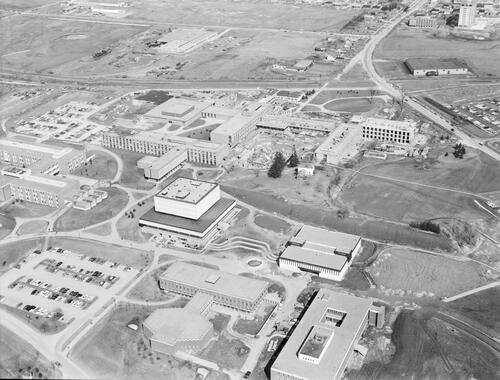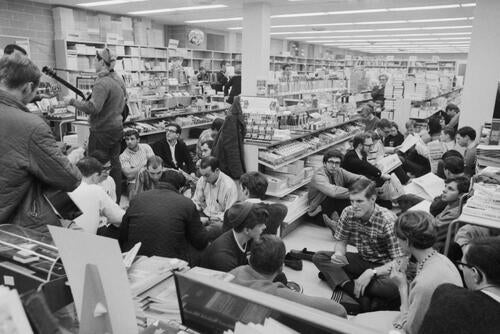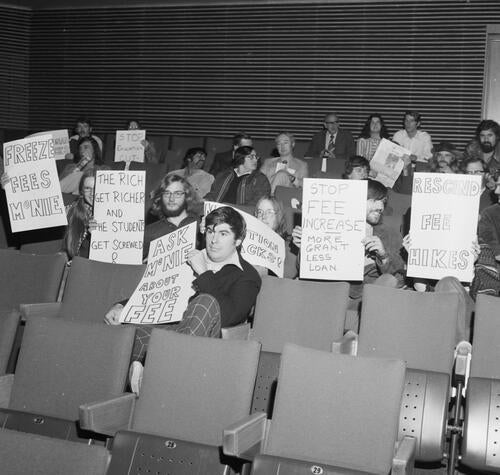
Remember when: Burning the dog
As they celebrate a milestone anniversary, alumni look back on an unforgettable event in Waterloo's history

As they celebrate a milestone anniversary, alumni look back on an unforgettable event in Waterloo's history
By Megan Vander Woude Office of AdvancementIf you were a Waterloo student in 1968, you might remember an event that drove the media and police to campus in throngs. That day remains clear in Glenn Sutton’s (BSc ’72) mind 50 years after his graduation.
It was a protest against the Vietnam War. More specifically, against the use of napalm. To show the violence and devastation napalm leaves in its wake, student protestors planned something drastic. They sourced their own napalm, and promised to burn a dog.
In a special episode of the Waterloo alumni podcast, you’ll hear from four alumni celebrating milestone anniversaries of their graduation, sharing what it was like as a student from 1967 to 1972. And of course, you'll hear about that fateful protest: the burning of the dog.
Listen to this episode or scroll through this page for a summary of the episode and historical pictures.
It was the late 1960s, and Waterloo's campus was very different from today — smaller, sparser and more remote.
University Avenue was quiet. Chris Fleming (BES '70), a Planning grad, explained that the four-lane road was there, but no shops or buses like we see today. The now-bustling university plaza didn't exist, and Lester Street wasn't filled with high-rise apartments. Instead, there were some single-detached homes and a water tower. (Yes, it's the one that Engineers defamed with their four beloved letters: B-E-E-R.)
 An aerial view of campus, taken in 1966, shows some familiar buildings in the centre of campus. Where did you spend your time as a student?
An aerial view of campus, taken in 1966, shows some familiar buildings in the centre of campus. Where did you spend your time as a student?
But on campus, some familiar buildings were popping up. A couple of the alumni in this episode lived in Village 1, or at least spent time there. A couple of them mentioned construction on a new student residence too. The University had just broken ground on Village 2. Some of you might know that building as Ron Eydt Village — now considered one of the older residence buildings on campus.
By the time the University celebrated its 10th anniversary in 1967, its physical footprint had transformed from portables to something more substantial: a campus. Between 1965 and 1969, Waterloo opened 17 new buildings.
 Many alumni will notice something off about Dana Porter Library (DP) here. In 1967, when this photo was taken, DP was significantly shorter with only seven storeys.
Many alumni will notice something off about Dana Porter Library (DP) here. In 1967, when this photo was taken, DP was significantly shorter with only seven storeys.
 In 1970, DP would open its final three floors to students. This photo shows construction on those floors in 1969.
In 1970, DP would open its final three floors to students. This photo shows construction on those floors in 1969.
It's probably no surprise that Waterloo students were dedicated to their work. Alumni confirmed that they spent a lot of time in class, and then they spent a lot of time studying in the library. Like many other generations, they spent hours in Dana Porter, where you've been able to hear a pin drop for more than 50 years.
 Alumni were quick to point out how accomplished and knowledgable their professors were. Bob Drimmie (BSc '72) explained that many of the Chemistry faculty actually came from jobs in industry, not academia.
Alumni were quick to point out how accomplished and knowledgable their professors were. Bob Drimmie (BSc '72) explained that many of the Chemistry faculty actually came from jobs in industry, not academia.
 In 1966, Waterloo established Computer Science as a separate department within Mathematics. Students had direct access to the University's computers, an unconventional practice encouraged by renowned Waterloo professor Wes Graham.
In 1966, Waterloo established Computer Science as a separate department within Mathematics. Students had direct access to the University's computers, an unconventional practice encouraged by renowned Waterloo professor Wes Graham.
Brian van Norman (BA '72), an English grad, spent much of his time in the Campus Centre, now called the Student Life Centre. He studied in quiet rooms on the second floor and spent his free time in the Bombshelter, where students gathered for jam sessions.
 For more than 50 years, students have gathered in the Campus Centre's great hall to socialize.
For more than 50 years, students have gathered in the Campus Centre's great hall to socialize.
 While today's students know that they're Warriors, they wouldn't recognize the mascot pictured in this image from 1968. At some point, the Spartan Warrior was replaced with a more friendly looking lion, named King Warrior.
While today's students know that they're Warriors, they wouldn't recognize the mascot pictured in this image from 1968. At some point, the Spartan Warrior was replaced with a more friendly looking lion, named King Warrior.
There were plenty of other places to drink and be merry. It's no longer there, but the second floor of South Campus Hall used to house a cafeteria, which doubled as a dance hall at night. It was a popular haunt for students and community members alike.
 Plaid and stripes dominate the fashion scene at this 1973 dance on campus.
Plaid and stripes dominate the fashion scene at this 1973 dance on campus.
But it wasn’t all parties and school work. Like other campuses around the world, Waterloo was host to protests, sit-ins and demonstrations in the late 1960s. Protestors banded together over issues within the campus community — from the price of tuition and books to hiring Marxist professors.
Many of the protests went beyond campus issues. The Vietnam War had been raging for more than 10 years, and it wasn't just American students who stood up to protest. Canadian campuses, including Waterloo, saw their fair share of anti-war demonstrations.
 In 1966, students took over the book store to protest the price of textbooks. The sit-in was successful, bringing lower book prices and a new policy that made all of Waterloo's student services break-even propositions.
In 1966, students took over the book store to protest the price of textbooks. The sit-in was successful, bringing lower book prices and a new policy that made all of Waterloo's student services break-even propositions.
 Student protests continued into the '70s, as you can see in this picture taken in 1972. As the decade worn on, protests became fewer and more focused on student issues at Waterloo.
Student protests continued into the '70s, as you can see in this picture taken in 1972. As the decade worn on, protests became fewer and more focused on student issues at Waterloo.
This brings us back to the protest that electrified the Waterloo community.
Brian, Chris, Glenn and Bob — all four of them mentioned the burning of the dog. As it turns out, Brian was one of the organizers, and he was able to recount how it came about:
"Someone — and I can't remember who — had the idea that we could get way better press if we … appeared to be extreme. So the decision came about that we should be burning a dog with napalm."
The plan worked. The group announced their intentions a few weeks before the demonstration would take place. News spread through campus, then spilled over into the wider community and beyond.
"It hit the papers across Canada,” says Brian. “About three weeks before this protest was supposed to happen, the police descended on the campus. If you had a dog, you were questioned pretty seriously. And when the event happened, of course there were all kinds of people, but there were really more media and police than anybody else."
Glenn was also present in the crowd, and remembers the event well.
"We all went down there to watch, and the police were there, ready to arrest them," Glen recalls. "They took out a pack and said, 'Here's the dog.' It was a hot dog."
Protestors really did have some napalm, and they did burn the hot dog with it. There were no dogs present, and no animals were harmed.
Some might call it trolling, others would say the protestors were smart alecks. Either way, Waterloo students have always had a knack for this sort of thing. From student protestors to entrepreneurs -- our ideas are ambitious, and we like to take the unexpected route.

Read more
Jack Schueler (BMath ’74) reflects on an unforgettable student experience

Read more
As Rick Leroux (BSc ’72) gears up for a milestone celebration with classmates, he recalls the experiences that bonded them together

Read more
Nancy McCalder (BA ’78) shares memories from campus as she plans her 50th class reunion
The University of Waterloo acknowledges that much of our work takes place on the traditional territory of the Neutral, Anishinaabeg, and Haudenosaunee peoples. Our main campus is situated on the Haldimand Tract, the land granted to the Six Nations that includes six miles on each side of the Grand River. Our active work toward reconciliation takes place across our campuses through research, learning, teaching, and community building, and is co-ordinated within the Office of Indigenous Relations.